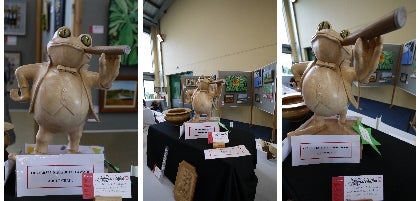If you use wide-angle lenses mostly for getting more in the picture then you’re missing out on a different perspective – one that prioritises perspective itself over angle-of-view.

Mr Toad, carved by Arthur Morley. Platinum winner and Best Adult Craft entry in the Jersey Eisteddfod 2010. Left to right, this composite contrasts the perspective associated with different lenses and different object distances. The elements show tight crop using a longer focal length, a wide crop using a shorter focal length and an ultra-close tight crop using the same shorter focal length. All photographs (c) Jon Tarrant.
At the risk of biting a hand that feeds I’m going to complain about those over-simplistic graphics that magazines love to use when trying to convey the effects of using different lenses without any regard for perspective. You’ve probably seen these diagrams; they typically have a wide-angle scene inside which a series of boxes show the crops that would be achieved using different lenses. The big problem is that all of these views are taken from the same point, which means that they have the same perspective.
Before going on we should be clear about the meaning of “perspective” in the photographic sense. The traditional meaning refers to the relationship between the elements in a scene and connects this relationship at the picture-taking stage with the same relationship when the image is viewed. Theory says that the obtain the correct perspective the captured image should be viewed at its as-captured size from the same distance as the focal length of the lens that was used to capture it. That would be very uncomfortable in many cases so it is usual to enlarge the image and then view it from a correspondingly greater difference (while keep the ratios the same).
In practice, a perfect perspective can look clinical and it is common for photographers deliberately to choose to use a focal length that will differ from the viewing perspective so as to give a more eye-catching effect. The nature of the effect varies depending on the focal length used. Long focal-length lenses are said to compress the perspective because their enlarged image appears to have been captured at close range but in fact that was not the case, so there is a much smaller range of object distances than would be seen in a genuine close-up image.
For example, consider a picture of a fox walking across a field. In a wide-angle view the fox would be very small so you might try to get closer either physically or optically in order to take a picture in which the fox is bigger than it would otherwise be. Moving closer (in a hide) might mean that the fox is now just a couple of metres away from you – and the hedge in the background might be another two metres beyond the fox. So the fox is half the distance of the background and those distances will define the perspective in the resulting picture.
If you don’t have the time or patience to erect a hide then you might simply fit a 400mm lens (or similar) to close-in on the fox optically. The fox would still be, say, 20m away but it might look as large as if you had been in the nearer hide. The background, however, would look very different because it is now just 10% further away than the fox – and would therefore look closer in the resulting picture. This is the effect of perspective.
And here’s my gripe with those over-simplified graphics: if you want to get less in your picture then don’t simply swap to a longer focal-length lens, instead try moving a bit closer and watch what happens to the perspective in the picture. It used to be said that the cheapest zoom lens was a pair of legs and it’s a shame you don’t hear that saying very often these days.
The composite image I’ve included is intended to illustrate the effect of perspective and in the outside two images you can very clearly see the difference when a similar reproduction-ratio is captured at very different distances using very different lenses. The middle image is akin to the field-of-view graphic that I’ve been talking about and clearly, I think, it isn’t a picture that any serious photographer would choose to take when faced with such a magnificent subject!





